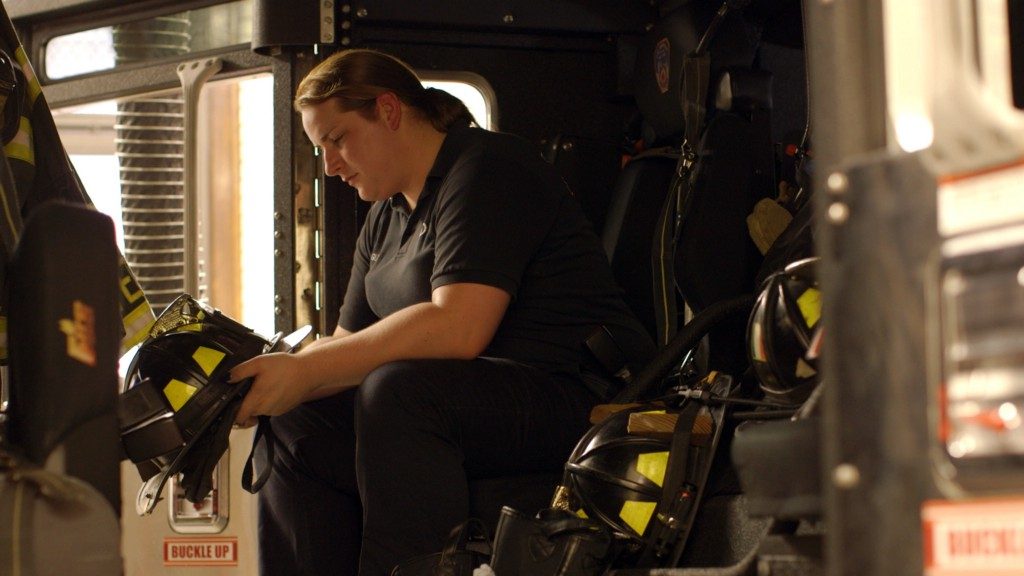Julie Sokolow’s films have appeared at the New York Times, TIME, and Huffington Post. Her feature film directorial debut, “Aspie Seeks Love,” won Best Documentary at the 2015 Cinequest Film Festival and gained acclaim in Vice, Filmmaker Magazine, and Salon. She is the creator of the Healthy Artists documentary series, which profiles over forty uninsured artists who struggle to afford health care. “Woman on Fire” is her second feature film.
“Woman on Fire” will premiere at the 2016 DOC NYC film festival on November 15.
W&H: Describe the film for us in your own words.
JS: “Woman on Fire” tells the story of Brooke Guinan, the first openly transgender firefighter in NYC. We follow her journey as a kid growing up in the suburbs of Long Island to now in her 20s, rising as a role model on billboards in Times Square. We also learn about Brooke’s unique family — both her father and grandfather are firefighters.
The film is a heartfelt portrait of Brooke’s family life, love life, and her struggle to be her true self in one of the most traditional professions in the world.
W&H: What drew you to this story?
JS: I first learned about Brooke when a photo of her went viral. She’s standing tall in her firefighting helmet and a shirt that reads, “So Trans So What.”
The photo was accompanied by interviews with Brooke and her father George, a respected FDNY lieutenant with 35 years on the job. He’s also a devout Christian and Republican.
Brooke and her father’s relationship seemed to embody the polarized political forces in America today. I wanted to explore what it was like for them to coexist in the same family and workplace.
W&H: What do you want people to think about when they are leaving the theater?
JS: I hope people recognize the story’s universality. We’ve all had moments when it’s difficult to be true to ourselves at work, at home, or in our relationships. If people can relate to Brooke’s story, then hopefully they’ll leave the theater with a new sense of respect for transgender people.
I also hope that women and LGBTQ people in particular can draw inspiration from Brooke’s bravery in pursuing her own dreams.
W&H: What was the biggest challenge in making the film?
JS: Editing the film was the biggest struggle, because I wanted to cover every moment of Brooke’s dynamic life. She was busy recruiting and training women and LGBTQ people for the fire department all while buying a house with her partner Jim and considering marriage.
So the film is part work story, part love story, and part family story. Editing took a lot of grueling work over the course of one year.
W&H: How did you get your film funded? Share some insights into how you got the film made.
JS: The film was produced by Animal, a Sundance-winning production company with incredible titles to its name. I’m very fortunate that Animal and my producer Danny Yourd were with me every step of the way, believing in both me and Brooke’s story. We also received a completion fund grant from Frameline, which supports LGBTQ films.
W&H: What does it mean for you to have your film play at DOC NYC?
JS: We’re thrilled to have our world premiere at DOC NYC. Our whole cast is going to be there on opening night to celebrate and meet the audience.
Our second screening is at IFC where I used to see movies as a teenager. We’re having our premiere in the heart of where we’ve lived and breathed this story to life, which is amazing.
W&H: What’s the best and worst advice you’ve received?
JS: The best advice was to keep the film focused on Brooke — I’m really glad Brooke is clearly the main voice.
The worst advice was to give the men in the story more screen time. There are a lot of compelling people surrounding Brooke’s life and it was easy to get seduced into a more ensemble approach, but it was important to us to center Brooke’s voice in telling her own story.
W&H: What advice do you have for other female directors?
JS: Embrace the challenge. Do it because it’s hard, not even though it’s hard. Your story is important, but you will sometimes have to stand up against naysayers to tell it. That’s part of the journey.
W&H: Name your favorite woman-directed film and why.
JS: There are too many to name! I’ll always love Miranda July’s “Me and You and Everyone We Know.” It’s funny and beautiful and the fact that she wrote, directed, and starred in it inspires me.
W&H: Have you seen opportunities for women filmmakers increase over the last year due to the increased attention paid to the issue? If someone asked you what you thought needed to be done to get women more opportunities to direct, what would be your answer?
JS: There’s a lack of funding for documentaries and independent films in general, and that impacts everybody. If we want to ensure that women, people of color, and LGBTQ people get to direct their visions, we have to create spaces for that. I’m inspired by the existence of support systems like Frameline, Chicken and Egg, and ARRAY.
On a broader cultural level, I think we have to acknowledge that we love watching movies and therefore need to support the myriad of hardworking, passionate people who make them.







